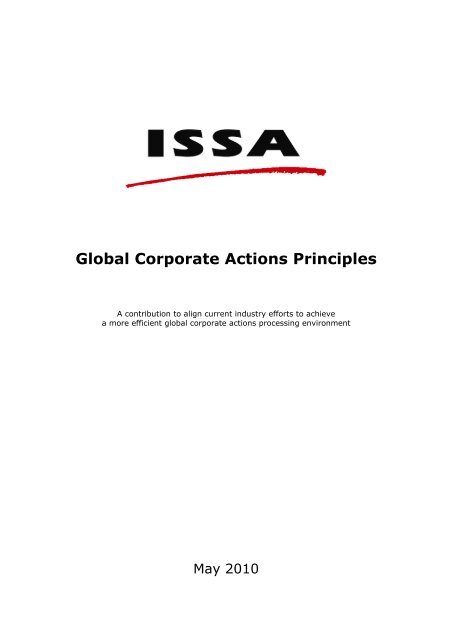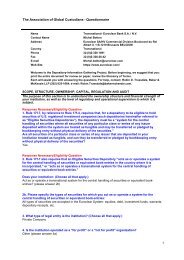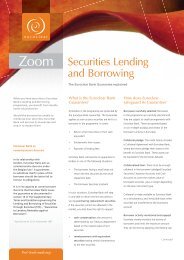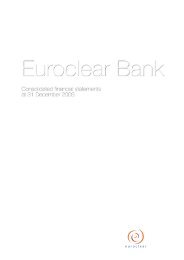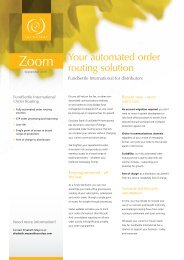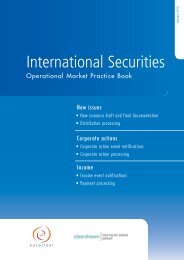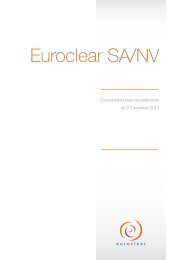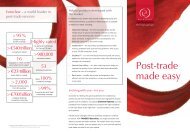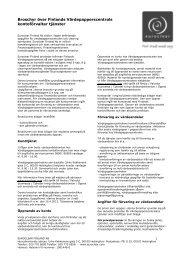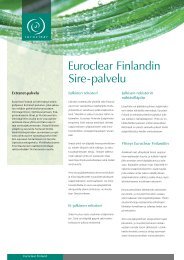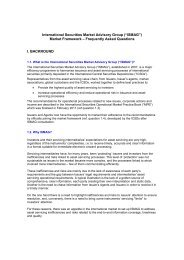ISSA Global Corporate Actions Principles - Clearstream
ISSA Global Corporate Actions Principles - Clearstream
ISSA Global Corporate Actions Principles - Clearstream
- No tags were found...
You also want an ePaper? Increase the reach of your titles
YUMPU automatically turns print PDFs into web optimized ePapers that Google loves.
<strong>Global</strong> <strong>Corporate</strong> <strong>Actions</strong> <strong>Principles</strong>A contribution to align current industry efforts to achievea more efficient global corporate actions processing environmentMay 2010
International Securities Services Association <strong>ISSA</strong><strong>Corporate</strong> <strong>Actions</strong> Working GroupSummary Objectives• To synthesize existing and emerging global industry initiatives on corporateactions processing and thereby publish principles that would facilitate riskreduction, efficiency, investor protection, and issuers’ ability to reach a broadinvestor base, highlighting gaps in current practices and areas that would benefitfrom concerted action.• To facilitate the alignment of efforts among the various industry groups andadvocate these principles globally to relevant stakeholders — the entire securitiesinvestment industry, issuers and their agents, and regulators — and facilitate themonitoring of issues and developments in key markets around the world, withrespect to the principles.• To highlight recommended practices being implemented or plannedaround the world, and provide a one-stop reference point to relevant work beingdone by industry groups globally, with links to their websites.ScopeThis document describes proposed global principles for improving the standardization ofcorporate actions and income processing end-to-end, including cash and stock distributions aswell as reorganizations; for listed equities and for fixed-income instruments held in book-entryform at central depositories, synthesizing or rationalizing current industry initiatives. Proxyvoting and class actions were considered but left out of scope. Tax processing and foreignownership limit reporting are not in scope. Unlisted securities were not excluded from theproject scope but differences between listed and unlisted securities were not examined.Addressees of this ReportThis paper is addressed to issuers and their agents, market intermediaries such as custodianbanks, asset managers, industry associations/groups, market infrastructures and regulators.We encourage them to support (if not yet in place) the establishment of MarketImplementation Groups (MIGs) by elaborating:• a framework for adapting requirements to local market needs• suggestions for cross-market co-ordination within and across regions, including themonitoring of the progressFurther, this paper is suggested reading for all individual market participants and their agentsinvolved in designing, announcing and processing corporate events. It is a contribution tocross-fertilize the industry and improve the understanding of all elements of a successful endto-endprocess. All interested parties are invited to join the dialogue with <strong>ISSA</strong> on whatremains to be done to close the gaps and achieve progress jointly, to the benefit of all marketparticipants and their clients.AcknowledgementsThis report is the result of an effort by a small team of experts drawn from <strong>ISSA</strong> members andthird parties, led by Citigroup. A number of <strong>ISSA</strong> member firms and third parties suppliedvaluable market information, covering more than 50 markets. The names of all participatingfirms and the individual contributors are listed on page 34. Their original input is accessible onwww.issanet.org. The <strong>ISSA</strong> Executive Board wishes to thank all supporters for their personalcontribution and their firms for having enabled their participation.This report draws on work completed or currently driven by a number of other industry groups.They are listed in Section 4.May 2010 6
International Securities Services Association <strong>ISSA</strong><strong>Corporate</strong> <strong>Actions</strong> Working Group2. <strong>Global</strong> <strong>Principles</strong><strong>ISSA</strong> endorses the following principles which aim at reducing risk, improving efficiency byminimizing ambiguity in communication, establishing workable timelines, enabling straightthroughprocessing, and promoting international harmonization of end-to-end standards forcorporate actions.Paperless, Automated Information Exchange1. Straight-Through Processing (STP) and ISO StandardsCommunication should be electronic to ensure an STP flow along the intermediary chainfrom the issuer to the investor and vice versa. Messaging must be in ISO format and instructured standardized data form across the issuer to investor chain. In implementingISO standards, local market practice will be adopted as defined by NMPGs (NationalMarket Practice Groups), and ISO ‘Extensions’ adopted if agreed local market practicecannot be accommodated within the existing global standard and harmonized globalmarket practice.2. Message ContentThe content of messages must be clear, contain all known key information and unambiguous.In particular, all key dates and critical information affecting an event must be carriedin the event announcement.Event Creation3. Issuer Sourced Key InformationKey summary information must be created by the issuer. It should be, at a minimum,consumable and accessible using the ISO repository of data elements and subsequentlyusable in structured ISO format and should be simultaneously published to the local exchangeand CSDs, regulators and the open market. Issuers should also make prospectusdocuments (e.g. event terms and conditions) available on public websites. Updates shouldcontain all known information, as a best practice, and recipients should manage anydiscrepancies from previous messages.4. Required InformationSubject to compliance with legal requirements, only information that is required for theevent type should be carried in the announcement, i.e. only data functionally necessaryfor processing in an electronic, structured way, as defined by designated organization(s) ineach market, implementing standards consistent with global ISO standards. This informationmust be unambiguous, and should not exclude the use of text in defined fields asused in ISO formats. Other optional information should be retained and accessible atsource.5. Unique IdentifiersRequired information must include a unique global event identifier that is assigned at theearliest possible point and remains with the event throughout its lifecycle, despite updates.Issuer and security codes should uniquely identify the issuer as well as the listinglocation, e.g. using ISIN and MIC.May 2010 7
International Securities Services Association <strong>ISSA</strong><strong>Corporate</strong> <strong>Actions</strong> Working Group6. Timelines of NotificationEvent CommunicationNotifications to the chain of intermediaries and to the end investor must be made in atimely manner and as close as possible to the issuer's announcement date and time. Sufficientnotice to execute the event, including amendments to the event, must be given toallow all parties to complete the process effectively before the event deadline.7. Process HarmonizationEvent ProcessingWhere global or regional standards do not already exist, each market should agree itsstandards for corporate actions processing and, in parallel, aim at convergence of standardsacross markets.Processing should involve book-entry payments for both cash and securities proceeds.Standard election option identification conventions should be adopted to facilitate the electionprocess.Clear rules should be published by markets on the processing of reversals, which shouldbe pre-advised in all cases and should require the prior consent of intermediaries beyondagreed deadlines and amounts.8. Publication of Event Processing RulesEvent processing rules and templates should be harmonized as far as possible, and publishedin a coordinated way for global consumption and adherence.9. Protecting Investors' RightsTransaction Management, Unsettled TransactionsClear rules concerning buyer protection, market claims (and any other instances wherebuyers' rights may be affected) should be established in each market and consistentlyfollowed, if possible by a central market infrastructure. Equally, consistent transformationmethods should be established and applied.Explanatory NotesEvent Creation and Event CommunicationEvent creation and announcement will follow legal requirements in the issuer’s jurisdiction butinclude internationally agreed required static and dynamic data, with clear ownership of eachdata field and provisions for local exchanges and depositories to add designated data fieldswhich they are responsible for. Issuers should be aware that transmission of the announcementto the ultimate investor may involve multiple intermediaries and time zones. Announcementwill therefore be completed with sufficient notice for intermediaries (and investors, for electiveactions) to execute instructions (and decide, for elective actions). Normally this will meanissuer's announcement at least five business days before record date or at least 15 businessdays before market deadline, as applicable, with intermediaries relaying information within onebusiness day of receipt. Timeframes should be established beyond which changes will requireextension of record dates or market deadlines.May 2010 8
International Securities Services Association <strong>ISSA</strong><strong>Corporate</strong> <strong>Actions</strong> Working GroupAnnex B provides additional information on event creation and the scope and content ofinformation to be communicated."Required data" should be distinguished from "information required by the investor to make aninvestment decision". The former relates to data functionally necessary to process thetransaction in an electronic, structured way. The latter should be kept to the minimum.Investors should recognize that it remains prudent to refer to the prospectus as the ultimatesource of complete information.The goal should be to have event information transmitted in structured format from the issueracross the chain to the investor. Until such information is made available, infrastructuresshould be responsible for picking up relevant information and relaying it accurately and as earlyas possible through the intermediary chain to the investor. There must be provision forenrichment by addition of designated data fields by CSDs and exchanges.The issuer or its agents, and (until electronic announcements in standardized formats are inplace) issuer’s CSD or designated data distributor, and all intermediaries will be responsible forpassing on event-related information and any update in an electronic, structured way to thenext point in the chain as soon as possible. The information flow between the issuer’s CSD ordata distributor and successive levels of investor intermediaries will be in structured ISOformat 1 and, where applicable, according to agreed service level agreements. Any narrativetext should be in an internationally accepted language in the industry, currently English. Freetext narrative should only be used if there is no other way to convey the information. The goalof getting structured information directly from the issuers should really extend beyondcorporate actions to terms and conditions of original issuance 2 .Key datesBesides announcement and payment dates, key dates common to all types of corporate actionsare:• Ex-Date 3, for all distributions, preceding record date by one settlement cycle minus onebusiness day• Record-Date 4 , for all distributions and mandatory reorganizations without options• Start of election period, for all reorganizations with options and distributions withoptions, preferably minimum 10 business days before market deadline• Buyer protection deadline and market deadline, for all reorganizations and distributionswith options (buyer protection deadline preceding market deadline)• Last trading date, preceding record date by minimum one settlement cycle; formandatory reorganizations only.• Guaranteed participation date, for voluntary reorganizations (as a best practice:preceding the buyer protection date by minimum one settlement cycle plus two hours)Event ProcessingProcessing for all event categories should utilize standardized data in ISO format (using theSecurities Market Practice Group's Event Interpretation Grid) and standardized deadlines percategory. Processing should involve book-entry payments, credit of benefits on pay date, and1 As an example of implementation: There is currently a joint initiative driven by SWIFT, DTCC and XBRL USpromoting the use of XML/XBRL in conjunction with ISO 20022.2 as pointed out by ISMAG3 Ex-date: Date from which trading (Exchange and OTC) occurs on the underlying security without the benefit /the right at the intermediary level.4 Record-date: Date on which (at close of business) settled positions are struck to determine the parties who areentitled to the corporate action and the size of their entitlement at the CSD level.May 2010 9
International Securities Services Association <strong>ISSA</strong><strong>Corporate</strong> <strong>Actions</strong> Working Groupelectronic election instructions where applicable. Rules for handling fractions and fordetermining entitlements for borrowed securities should be clear and harmonized not onlyacross all issuers per market but also for cross-border business. Reversals should be advisedwithin reasonable and agreed timeframes. Market defaults should be applied to loaned orborrowed positions if not otherwise agreed in service level agreements.For elective corporate actions, deadlines should be adjusted by issuers only under exceptionalcircumstances and if permitted by applicable laws. Intermediaries should follow-up for lateelections (depending on service level agreements), and default options previously notifiedshould be applied if a client does not elect.Distributions with options will be represented by an interim security and treated as twoseparate corporate actions announced simultaneously, the first being a distribution, the seconda mandatory reorganization with options 5 . For reorganizations with options, each option shouldhave a unique identifier specified by the issuer, and a new ISIN should be allocated to eachoutturn security.To minimize systemic risk and reduce inefficiencies and re-work, clear rules should bepublished by markets on the processing of reversals, which should be pre-advised in all casesand should require the prior consent of intermediaries beyond agreed deadlines and amounts.Elective eventsInvestors’ agents will be responsible for relaying their clients’ election instructions to theissuer’s CSD or agent, or to their intermediary custodian agents as soon as possible and instructured ISO format, where applicable according to agreed service level agreements. Themarket deadline for receiving valid instructions at the issuer’s CSD or agent, announced atevent creation, will allow sufficient time for instructions to flow across the intermediary chain tothe ultimate investor, and responses to flow back. No paper documentation should be required.The use of standard conventions for election option identification will facilitate STP as well asreduce error rates, as currently options are often numbered differently by differentintermediaries.The asset managers are part of the end-to-end process and should be linked into theintermediary chain using electronic messaging. The use of fax as a response tool should bephased out as soon as possible.Transaction Management, Unsettled TransactionsCSDs should generate market claims on matched transactions to ensure that proceeds ofdistributions reach contractually entitled parties who have not received their full entitlement onrecord date. Transformations should be implemented by CSDs as a process in which pendingtransactions in a reorganization are replaced by new instructions. Buyer protection should beimplemented where possible by CSDs on elective corporate actions, to ensure that buyers whohave the right to elect (but do not hold securities because of pending transactions) receive theoutturns of their choice.There are markets, however, that follow a different model where the CSD is not involved in theentitlement distribution and/or the claims management process. Two notable examples areillustrated below:5 DRIPs (Dividend Reinvestment Programs) are not considered distributions with options but cash distributions orsecurities distributions, depending on the investor's decision. In case of doubt, regional or local market bodieswill determine which specific distribution with option types will not require an interim security (e.g. US DVOPs).May 2010 10
International Securities Services Association <strong>ISSA</strong><strong>Corporate</strong> <strong>Actions</strong> Working GroupJapanIn the Japanese book entry share environment, investors (who are account holders withfinancial institutions) have their share balance as of record date registered in the issuer'slist of shareholders, and thus have full rights as shareholders or their agents. Issuersdistribute all entitlements, such as dividends, directly to the shareholders (not through theCSD). After the list of shareholders as at close of business on record date is drawn,claiming dividends through the CSD is neither possible nor would it be efficient. Brokersthat bought shares on a cum-dividend basis but do not receive the shares on or beforerecord date, have to claim the dividend from their trading counterparty. For on-exchangetrades, the claims process for dividends and other rights arising out of failed deliveries, isgoverned by rules set by the Japan Securities Clearing Corporation (i.e. the market'scentral counterparty).South AfricaFor On Market Transactions, claims are managed by the stock exchange. Off Marketclaims are managed at the individual investor level. The introduction of a 'Last Day toTrade' concept has greatly reduced market claims as investors have a clear indication ofthe last point to trade to qualify for an entitlement. Last Day to Trade is the day precedingthe ex date.3. Enabling Adherence to the <strong>Principles</strong>Applying the general principles outlined in the previous chapter in daily business, calls fordifferent steps to be addressed in sequence by the different constituencies that are involved inmanaging corporate actions: first the standards setting, second the implementation (ISOstandards, common taxonomy) and third, the specific solutions to support straight-throughprocessing (e.g. XBRL, screen-based interfaces).The objective should be to leverage across geographical locations the standardsettings already achieved and to share best practices and principles on the largestscale possible. Priority should be to agree standards globally prior to looking atimplementation matters.The major constituencies that are affected and involved are: Issuers and their agents; marketinfrastructure; intermediaries such as custodian banks; and institutional investors.Issuers and their AgentsThey "own" most of the information elements provided in a corporate action announcement.They should− Provide clear, concise information in electronic form in adherence to ISO standardsand agreed market practice not less than five to fifteen business days before a keyprocessing date.− Communicate updates not less than two business days before a key processing date,unless schedule relief is offered to accommodate processing of the changedownstream to reach the investor constituency.May 2010 11
International Securities Services Association <strong>ISSA</strong><strong>Corporate</strong> <strong>Actions</strong> Working Group4. Industry Groups and Initiatives of <strong>Global</strong> SignificanceMost principles incorporated in this paper have been derived by synthesizing and building onthe considerable body of work done on the subject by other industry organizations with a global,regional or functional focus. It is our objective to support their work on a global basis byhighlighting best practices with broad applicability, and by encouraging their adoption across allstakeholder groups so as to reduce risks and costs in these complex processes. A – certainlyincomplete – list of organizations and initiatives of global significance whose work was used asreference for this report includes the following:Region Organization Acronym<strong>Global</strong><strong>Global</strong><strong>Global</strong><strong>Global</strong>International Organization for Standardizationwww.iso.orgThe ISO 20022 standard is a business model based standard processfor the development of messages for the global financial services industry.Society for Worldwide Interbank Financial Telecommunicationwww.swift.comSWIFT has been heavily involved in the establishment and implementationof the ISO 20022 infrastructure, including messages to processcorporate actions. SWIFT is the Registration Authority for the ISO20022 standard.Securities Market Practice Groupwww.smpg.infoThe <strong>Global</strong> Securities Market Practice Group (SMPG) facilitated bySWIFT has completed extensive work on ISO messaging standards andthe Event Interpretation Grid (EIG), and is continuing to define keyinformation elements, process flows, and templates. Industry-wide, theSMPG and its associated National Market Practice Groups (NMPGs)play a significant role in agreeing and documenting local marketpractice, and in defining how ISO messages should be used given theexisting diversity in national market practice.International Securities Market Advisory Groupvia www.clearstream.com or www.euroclear.comISMAG includes senior executives from the issuing, asset servicing andinvestor communities, is aiming to increase end-to-end processingefficiency and STP through the standardization of issuance practices, aswell as information dissemination and processing of corporate actionsand income distributions of international securities settled in the ICSDs.ISMAG has finalized an Operational Market Practice Book setting abaseline for the service delivery by all intermediaries in the assetservicing chain. It defines roles and responsibilities of the end-to-endintermediaries and the flows for timely dissemination. ISMAG is alsodefining information checklists and templates regarding the specificdata required by intermediaries in the securities informationdocumentation as well as in the event notification for predictable andunpredictable corporate action events.ISOSWIFTSMPGNMPGISMAGMay 2010 13
International Securities Services Association <strong>ISSA</strong><strong>Corporate</strong> <strong>Actions</strong> Working GroupRegion Organization Acronym<strong>Global</strong><strong>Global</strong><strong>Global</strong><strong>Global</strong>Africa &MiddleEastAmericasAmericas(U.S.)International Securities Association for Institutional TradeCommunicationwww.isitc.orgRepresenting around 350 companies worldwide, ISITC developsproposed standards that are designed to enhance efficiency in tradeprocessing and related communications.The U.S. <strong>Corporate</strong> <strong>Actions</strong> Working Group within ISITC examinesbusiness processes throughout the life cycle of a corporate action. Goalis to define standards for the US market and examine variances withglobal market practice, for the purpose of harmonizing corporate actionmessaging standards and move toward increasing automation andachieving greater STP throughout the industry.Association of <strong>Global</strong> Custodianswww.theagc.comThe AGC is a group of currently ten global custodian banks that aremajor providers of securities custody and trade settlement services toinstitutional investors worldwide. The association primarily seeks toaddress regulatory and market structure issues that are of commoninterest to global custody banks. In 2007, the AGC published a WhitePaper that discusses the need to automate and standardize corporateaction messaging at every stage of event communications.International Securities Services Associationwww.issanet.org<strong>ISSA</strong> provides leadership in the formulation and promotion of bestpractice to improve efficiency and risk management in the global assetservicing industry. <strong>ISSA</strong> fosters cooperation across borders andindustry sectors in areas where joint initiatives benefit marketinfrastructure, institutional market participants and investors.World Federation of Exchangeswww.world-exchanges.orgAfrica & Middle East Depositories Associationwww.ameda.orgAmericas Central Securities Depositories Associationwww.acsda.orgCurrently (Early 2010) ACSDA is completing a survey of current corporateaction rules and market practices across the Americas, anddefining best practices.Asset Managers Forumwww.theassetmanager.comThe US Asset Managers Forum (AMF) and SIFMA have developed detailedrecommendations on corporate actions handling from the viewpointof institutional investors and their fund managers.ISITCAGC<strong>ISSA</strong>WFEAMEDAACSDAAMFMay 2010 14
International Securities Services Association <strong>ISSA</strong><strong>Corporate</strong> <strong>Actions</strong> Working GroupRegion Organization AcronymEuropeEuropeEuropeEuropeEuropeEuropeEuropeEuropeEuropeEuropeEuropeJoint Working Group 'General Meetings'A parallel working group drawn from the same associations as theCAJWG, looking into issues specifically related to General MeetingsThe European Commission’s Clearing & Settlement Advisory andMonitoring Expert GroupCESAME2's mandate is to facilitate a barrier-free Single EuropeanMarket for clearing and settlement of securities transactions. It is composedof 30 high-level representatives of various, mainly privatesector,bodies involved in post trading, and observers from publicauthorities.European Fund and Asset Management Association / EFAMAFund Processing Standardisation Group (FSPG)www.efama.orgA working group within EFAMA is looking into ways and means toachieve efficiency gains in corporate actions processing for Europeanmutual funds (UCITS funds). The principles and standards defined bythe CAJWG for conventional securities serve as primary reference.European Association of Central Counterparty Clearing Houseswww.eachorg.euEuropean Association of Co-operative Bankswww.eurocoopbanks.coopEuropean Banking Federationwww.fbe.beEuropean Central Securities Depositories Associationwww.ecsda.comEuropean Issuerswww.europeanissuers.euEuropean Savings Banks Groupwww.savings-banks.comFederation of European Securities Exchangeswww.fese.orgTARGET2 Securities <strong>Corporate</strong> <strong>Actions</strong> Sub-Grouphttp://www.ecb.int/paym/t2s/progress/subcorpact/html/index.en.htmlJWGGMCESAME,CESAME2EFAMAEACHEACBEBF / FBEECSDAEuropeanIssuersESBGFESECASGMany markets – typically in Western Europe but not limited to that region - have MarketImplementation Groups (MIGs) whose composition is representative of their marketstructure. Once new regulation, standards, best practices etc. have been developed and agreed,the task of the MIG is to promote, coordinate and drive the implementation phase within theirmarket. The MIGs can, but need not be identical with the National Market Practice Groupsunder the umbrella of SMPG.May 2010 16
International Securities Services Association <strong>ISSA</strong><strong>Corporate</strong> <strong>Actions</strong> Working GroupRegion Initiative Acronym<strong>Global</strong>Americas(U.S.)Europe(Switzerland)XBRL Internationalwww.xbrl.orgXBRL(eXtensible Business Reporting Language) is a technical, XML basedlanguage for the electronic communication of business and financial data.XBRL enables issuers to electronically tag data within the prospectus orother documents. The tags are machine readable and can be importeddirectly into ISO 20022 messages for onward straight-throughprocessing.DTCC, SWIFT and XBRL US, supported by ISO, have launched aninitiative in the United States to adopt XBRL to tag event announcementinformation generated by issuers and their agents, so as to be able toproduce ISO standard messaging directly from issuer announcements.The use of XBRL technology enables issuers and their agents to useelectronic data tagging technology already coming into use in severaljurisdictions for regulatory financial reporting purposes.Similar pilots are planned or are under discussion in all continents.i2i Group (Issuer to Investor)www.xbrl.us/i2i/Pages/default.aspxSee under XBRL InternationalCONNEXORwww.connexor.chSIX Group launched a web-based infrastructure ("Connexor") for eventcapturing and supporting an automated electronic information flowbetween issuers, market infrastructures, intermediaries and vendors(implementation in phases, from late 2009). The solution is being testedin the Swiss market, it is however not limited to any market. Connexorsupports consistent straight through processing and enables issuers tomanage their reference data cost-efficiently along the entire life cycle of aproduct.XBRLi2i GroupConnexorMay 2010 17
International Securities Services Association <strong>ISSA</strong><strong>Corporate</strong> <strong>Actions</strong> Working GroupWho is Working in Which Field?The table below cannot claim to be complete. In most markets, individual organizations such as the stock exchange and the central depository arekey parties involved in harmonizing, standardizing and automating corporate actions processing within their sphere of influence. Those are not listedindividually. Acronyms: Refer to table on the preceding pages.GoalMarket Practice, Process Harmonization Process Automation, STP EnforcementInvestor Issuer InfrastructureIntermediaryInvestorSMPGSMPG<strong>ISSA</strong>WFEISTIC SEC SECSECSECNMPG NASDAQ NASDAQ NASDAQ NASDAQSIFMACAJWG MIGs CESAME2 CESAME2 NPMGsJWGGMMIGsMIGsCAJWG MIGs MIGs MIGs MIGsJWGGMIssuer InfrastructureIntermediaryInvestor Issuer InfrastructureIntermediaryGLOBAL ISMAG ISMAG SMPGSMPG ISMAG ISMAG SMPGSMPG AGC<strong>ISSA</strong> XBRL SMPG AGC<strong>ISSA</strong><strong>ISSA</strong>XBRL<strong>ISSA</strong><strong>ISSA</strong>Americas USA I2I Group ISTIC ISTICISTIC I2I ISTIC ISTICNMPG NMPGNMPG Group NMPG NMPGSIFMA SIFMA SIFMA XBRL SIFMA SIFMAI2I Group AGCI2I Group AGCXBRLAll ACSDA ACSDAEurope EU CAJWG CAJWG CAJWG CAJWG CAJWG CAJWG CAJWGJWGGM JWGGM JWGGM JWGGM JWGGM JWGGM JWGGMEuropean ECSDA AFME/ ESSFISMAG AFME/ ESSFIssuers AFME/ ESSFECSDAAFME/ ESSFnon- European ECSDA CAJWG CAJWG CAJWG CAJWG CAJWGEUIssuers AFME/ ESSF JWGGM JWGGM JWGGM JWGGM JWGGMAECSDA AFME/ ESSFCONNE- ECSDA AFME/ ESSFXOR AECSDA CONNEXORAFME/ ESSFCONNEXORAsia-Pacific All ACG APASWG ACG APASWGMiddle East& AfricaAll AMEDA AMEDAMay 2010 18
International Securities Services Association <strong>ISSA</strong>5. Assessment of the World Regions Against the <strong>Principles</strong>The summaries below were compiled by the core working group, based on local marketdescriptions contributed by institutions representing more than 50 countries. The originalinformation underlying these summaries can be found on www.issanet.org. Updates to theregional summaries or to individual market profiles will be published on the same website ifand when received.5.1 EuropeThe CAJWG Standards are a major achievement and the catalyst for all harmonization efforts inthe region. Endorsed in October 2009 by six industry associations representing the entire valuechain including the issuers, the CAJWG Standards are now the unanimously acknowledged bestpractice guideline for the coming years. Implementation is in progress on both a regional andnational level across all European Union member markets and at least the Western Europeannon-EU members as well. A detailed implementation plan and monitoring mechanism has beenagreed by all stakeholder industry groups (see Annex F). Additional weight and momentum isprovided by the fact that implementation is monitored by the EU Commission. For thesereasons, all survey respondents feel that any global recommendations must not contradict theCAJWG Standards and if they did, the CAJWG Standards would supersede anything else inpriority for the region.The Eastern European markets outside of the European Union (e.g. Russia, Ukraine) operate ina less integrated environment. Typical market features include multiple depositories, lack ofelectronic communication systems linking the full intermediary chain, and the widespreadcirculation of physical securities. Nevertheless, long term development in the corporate actionsarea is likely to be guided by the CAJWG Standards, too.Regional harmonization work has also started within the context of TARGET2 Securities withthe T2S <strong>Corporate</strong> <strong>Actions</strong> subgroup focusing on market claims, transformations, and buyerprotection, leveraging the CAJWG principles (see box below for more details).Regulators are already involved through the CAJWG being monitored by CESAME2, and the T2Scorporate action sub-group focusing on market claims and transformations being facilitated bythe European Central Bank.On the ICSD side, the ISMAG initiative has led to the definition of best practices forinternational securities primarily deposited in the ICSDs. Implementation is ongoing. The mainchallenge faced by ISMAG is to convince issuers, their lawyers and agents to adhere to ISMAGbest practices and implement the required changes. ISMAG is currently defining a marketenforcement framework in order to expedite implementation by issuers and their agents.Select Gaps in EuropeThe gaps most frequently mentioned include the lack of ISO-formatted data provided by theissuers, and the lack of agreed rules for market claims in some markets (e.g. Greece, Hungary).The lack of harmonized settlement cycles across markets is a major obstacle to regionallyharmonized event creation. The T2S project has shown the importance of harmonizing herefirst, and only then look to corporate actions.In Eastern Europe, the immediate challenges are decentralized infrastructures for assetservicing, lack of automation and facilities supporting straight-through-processing, and marketsbased on physical securities.May 2010 19
International Securities Services Association <strong>ISSA</strong><strong>Corporate</strong> <strong>Actions</strong> Working GroupHow will TARGET2 Securities Impact <strong>Corporate</strong> <strong>Actions</strong> Processing?TARGET2 Securities (T2S), to be operated by the Eurosystem and scheduled for completion in2014, is one of the major convergence initiatives in the European securities market. TheEurosystem comprises the European Central Bank and the National Central Banks of the Eurocurrency zone.T2S is an extension of TARGET2, the Eurosystem's real-time, large value payment system.The T2S platform will be the common technical basis for securities settlement in Europe, for allEuro-denominated trades and for a number of additional currencies as well. All settlements arein a true DVP mode against central bank money. As with money transfers within the Eurozone, T2S aims at eliminating the distinction between processing intra-CSD settlements andcross-CSD settlements. A very high level outline of T2S is shown below.O utline of TAR GET 2 SecuritiesNCB = National Central BankSource: European Central BankThe securities leg of a trade will settle in T2S via the securities accounts of the connected CSD.The cash leg will settle via the T2S cash accounts of the connected National Central Banks onwhich money is segregated for settlement (dedicated cash accounts). The T2S platform is theonly place where securities balances are allowed to change during the day. This means that allparticipating CSDs forward their trade settlement instructions to T2S. All free of paymentdelivery instructions and all deliveries against payment not related to stock exchange trades,must flow into T2S as well. At the end of each business day, T2S notifies all updated securitiesbalances back to the participating CSDs.T2S and <strong>Corporate</strong> <strong>Actions</strong>T2S centralizes the settlement function for all participating CSDs, but T2S is not a securitiesdepository. All securities continue to be kept in custody at the CSDs. <strong>Corporate</strong> actions and allother asset servicing tasks will be performed by the CSDs.There is a key conceptual distinction between corporate actions on settled and bookedpositions (also referred to as stocks in the T2S design terminology) and corporate actions onpending transactions (also referred to as flows).The principles of processing of corporate actions on stocks will not be affected by T2S. Today's"cascade" effect which starts at the issuer CSD and continues down the intermediary chain(which may include an investor CSD and custodian banks) will remain unchanged.May 2010 20
International Securities Services Association <strong>ISSA</strong><strong>Corporate</strong> <strong>Actions</strong> Working Groupversion). Local custodians generally use ISO standards in their client side communication, butnot necessarily with local market infrastructure.Among those markets that responded to the survey, South Africa stands out in severalrespects: It is clearly the most advanced in the region in terms of process automation, and ituses globally unique solutions to handle market claims and investor protection issues. Anexample is the Finalisation Date: the date on which the event and its details becomeunconditional in all respects and irrevocable, i.e. after which no further changes to any of thepertinent details can be made by the issuer and the event can only be cancelled in certaincircumstances. Another is the Last Day to Trade, which is the day preceding ex-date. Theintroduction of the Last Day to Trade has greatly reduced market claims as investors have aclear indication of the last point to trade to qualify for an entitlement.Select Gaps in the Middle East and AfricaNot all markets have yet adopted the series of key dates (ex, record, pay) that have becomean accepted global standard, nor a systematic process to detect and handle market claims.Systems development and automation based on ISO standards is generally low at all stages inthe processing chain, except for local custodians communicating with overseas institutionalclients.5.3 AsiaIn Asia, stock exchanges and central securities depositories are increasingly focused oncorporate action initiatives, with the objective of seeking accurate and efficient ways ofdistributing corporate action information and processing corporate actions. Compared to Europeand the Americas, the role of stock exchanges in this region is generally greater than that ofthe central securities depositories. It is recognized in some of the markets in the region thatthe active involvement of governments and regulators in the corporate action initiatives arenais essential to achieve the goal of STP for corporate actions.In addition, the Asia Pacific Asset Servicing Working Group which includes major regionalcustodian banks and SWIFT, has started a region-wide discussion in this area. The group'sobjectives are to improve the communication between issuers and investors, to help reduce thecosts and risks associated with asset servicing in the Asia Pacific countries by promotingstandardization and automation together with the establishment of market practices.Development of electronic messaging based on ISO standards in the Asian region has beengradual. Some of the markets have implemented or established a concrete plan for thedistribution of corporate action information in ISO standards. However, most of the marketsare at a very preliminary stage of such discussions.For corporate action processing for domestic clients, the involvement of intermediaries (e.g.custodian banks) is limited in certain cases due to the characteristics of the securities holdingsystem in the Asian region. In the direct holding system (i.e. securities are held in an accountwhich is opened by and under the name of a security owner directly within a central securitiesdepository system) no intermediaries are involved in the process. The same is true in theindirect holding system where the security owners’ benefit such as cash dividend and bonusissue etc. is distributed to owners directly by issuers (i.e. securities are held indirectly but theowner details will be passed to the issuers by the central securities depository).However, for non-resident investors the registration is generally made in the name of anominee and therefore corporate action processing is conducted by intermediaries. In thisregard, it is widely recognized that the harmonization of event creation, communication andprocessing is extremely important.As initiatives of integration of the capital markets evolve in Asia, corporate actionharmonization is expected to be discussed further.May 2010 22
International Securities Services Association <strong>ISSA</strong><strong>Corporate</strong> <strong>Actions</strong> Working GroupSelect Gaps in AsiaIt is recognized that the development of the straight through processing of corporate actions inthe Asian region in comparison with the “<strong>Global</strong> <strong>Principles</strong>” stated in this report is moderate.For instance, the implementation of unique identifiers and process harmonization across theregion has not been achieved. However, it is expected that growing cross border investmentsin the region will accelerate the discussion in the area of harmonization of the corporate actionprocessing within globally recognized standards.5.4 North AmericaThe U.S. market is moving towards ISO messaging, as DTCC (which includes the U.S. CSD,DTC) evolves from proprietary formats to ISO 20022 starting from early 2011 through 2015. Atthe same time, DTCC, SWIFT, XBRL U.S. and the U.S. market are working towards bringingissuers into the STP chain through the ‘issuer to investor: corporate actions’ initiative. This willbe a major evolutionary initiative that may involve regulators.The Canadian CSD, CDS, currently gathers information from issuers and transfer agents,scrubs it and disseminates in formats which include ISO 15022. CDS participates in the U.S.initiative to develop an XBRL taxonomy compliant with ISO 20022 standards, and plans to workwith transfer agents in future to facilitate direct electronic delivery of data from the source.The U.S. has a good foundation in defining the content within messages although there is stillwork to be done in harmonizing the content/usage across all U.S. security types, event typesand parties. It is expected that planning for XBRL adoption will accelerate the engagement ofissuers and their agents in the definition of standards by the U.S. national market practicegroup (NMPG), ISITC. DTCC’s corporate action re-engineering initiative will help furtherconsolidate the required content under a single set of templates. CDS chairs Canada’s NMPGfor corporate actions and actively pursues efficiencies through improved STP. In both markets,timeliness of announcements is not a major issue.In regards to the creation of a unique event ID, the XBRL taxonomy will introduce to issuersthe concept of a creating a reference ID to an event to be associated to all announcementsrelated to a single event through its lifecycle. DTCC will provide an event ID as part of thecorporate action re-engineering initiative, until issuers are able to generate the unique event ID.Harmonization issues exist,• where securities are settled in different markets (e.g. U.S. and Canada), all partiesneed to ensure alignment of local NMPGs.• where securities are multi listed i.e. traded/settled in different markets the sameapplies. The U.S. NMPG (ISITC) supports the Event Interpretation Grid (EIG) asdeveloped by the SMPG for general rules to assist in global harmonization. Local rules,which may be more detailed than the EIG, should be housed within the appropriatebodies and made publicly available.Through continuous net settlement (CNS) the U.S. market operates a centralized process thatin effect ensures investors are protected by the automatic adjustments on pay date. In addition,other mechanisms are in place to protect investors rights; for example, the due bill process fordividend type of events and the liability hub to net positions for elections on voluntary events.However, not all events are covered by the above processes. DTCC is working to close anygaps.CDS generates market claims on matched transactions, and offers buyer protection onvoluntary corporate actions through a web-based letter of liability service.May 2010 23
International Securities Services Association <strong>ISSA</strong><strong>Corporate</strong> <strong>Actions</strong> Working GroupSelect Gaps in North America1. Greater support and involvement in market practice by all parties impacted bycorporate actions.2. Greater coordination by all relevant industry organizations.3. Further develop the ISO 20022 data model.4. More involvement with transfer/payment agents and stock exchanges.5. Further analysis on other manual areas, e.g. between counterparties to close out acorporate action event e.g. swapping charges that occur in the Due Bill Process –expand on the obligation warehouse.6. The treatment of multiple-listed securities where different trading rules (affectingex-date) apply in different markets.5.5 Mexico, Caribbean, Central and South AmericaIn the last five years ACSDA has been very active regarding the corporate actions process. In2006, a <strong>Corporate</strong> Action Working Group was formed to examine the weaknesses and strengthsof the corporate actions process in the Americas. In 2007, the Working Group developed amatrix which identified the characteristics of each ACSDA member's service offering andproduced an overview of the region. It is recognized that, in this region where some of theworld's largest but also the smallest markets and CSDs operate, the standardization ofbusiness processes requires great efforts; and priorities and investment budgets differ greatly.However, progress has been achieved in the recent years. ACSDA’s participation ininternational forums related to corporate actions processing is growing stronger and there hasbeen a shift from acting as spectators in the beginning to now becoming an influential force.Considering the importance that corporate actions have taken globally, ACSDA has raisedsignificant awareness among its members of the challenges of standardization andharmonization, being key requirements to attract foreign investment into the region.The larger central depositories have committed to make their know-how available to supportthe smaller CSDs to implement cutting-edge technology and processes.Among the main achievements of the region, many ACSDA members have become participantsin the Securities Market Practice Group (SMPG) which focuses on corporate action bestpractices. The number of members continues to grow and some are even in the process ofestablishing national market practice groups.There is a need for the region to continue growing towards the principles identified in thisdocument. This derives from:• The fact that an increasing number of markets in the Americas are using ISO 15022 astheir message standards for transactions as well as for corporate actions. They havedesigned their systems in order to be able to migrate towards ISO 20022 in a smoothway.• They are beginning to use XBRL in corporate actions, in order to facilitate recordkeepingand communication.• The relationship among the industry groups involved in corporate action processing ischanging. Increasingly issuers, central banks, exchanges, regulators and otherscooperate to standardize and harmonize local information with the long term goal ofconverging to a single process globally. An example is the use of a single eventidentifier to facilitate centralized information collecting and distributing all events’schedules, calendars, rates, percentages, timings for key dates.• Many ACSDA members responded to the <strong>ISSA</strong> <strong>Corporate</strong> <strong>Actions</strong> working group survey,demonstrating their interest in participating actively in the development of global bestpractices.May 2010 24
International Securities Services Association <strong>ISSA</strong><strong>Corporate</strong> <strong>Actions</strong> Working GroupSelect Gaps in Mexico, Caribbean, Central and South AmericaThere is still work to do, such as looking for a greater participation of markets in theimprovement of STP, increasing efforts to strengthen relations between the different localplayers involved in corporate actions processing, and in the area of customer service. There arealso gaps to fill in those markets where the central depository is not the single entity holdingsecurities and therefore not the sole payor of cash distributions and other entitlements.May 2010 25
International Securities Services Association <strong>ISSA</strong><strong>Corporate</strong> <strong>Actions</strong> Working Group6. Implementation Monitoring ProcessImplementation monitoring with regard to the principles is a necessary element to achieveprogress. It is however a long-term undertaking and outside the scope of this project phase.The <strong>ISSA</strong> working group offers one possible approach for monitoring and presenting statusupdates on a global, regional or individual market level (see next page).As a first step, the organizations working in the different markets, world regions or globallywith the different constituencies should be identified. Those will be the bodies defining marketwidechange or improvement projects. The table on page 18 provides initial guidance withoutclaiming to be comprehensive.As a further precondition, an implementation strategy, followed by a more granular detailedtactical implementation plan should be agreed in each market for each principle. Meaningfulprogress monitoring should then report on the status of the detailed steps.For Europe, where the harmonization standards have been defined and agreed, a detailedimplementation and progress monitoring process on both a European and national market levelhas been defined. Implementation is in progress and is monitored by CESAME2 based on aEuropean Commission mandate. Regulatory involvement and pressure is thus part of theprocess. Annex F contains the relevant document, issued jointly by six leading Europeanindustry associations.May 2010 26
International Securities Services Association <strong>ISSA</strong><strong>Corporate</strong> <strong>Actions</strong> Working GroupA Possible Approach for Implementation and Status MonitoringThe table below is purely for illustration purposes. Its exact contents would have to be tailored to the specific monitoring task.StrategyTacticRegional ActivityGoal # Detail # Detail <strong>Global</strong> Americas Europe AsiaPac Africa1 Create Event Templates with data element ownership1S/NMPG to publically provide clear/concise event2 Develop process by which public access is permitted for all templatestemplates that meet Local and <strong>Global</strong> Market needs3 Ensure publicly announced Unique ID is provided by respective market body(ies)1: Create an Issuer to InvestorEvent templates should include Mandatory data to be 1 Define Data Elements as Mandatory, Conditional, Optional2 provided by the 3 constituencies: Issuer and2 Validate templates with all 3 constituenciesElectronic processInfrastructure, Intermediaries and Investors. 3 Gain public support/adoptionWork with appropriate ISO bodies to enhance ISO 20022 business model standards1ISO to adopt S/NMPG templates to ensure effective3messaging2 Work with appropriate ISO bodies to enhance ISO 20022 message standards3 Work with appropriate ISO bodies to permit variants as needed/required1 Define Event Types / Groups1 General <strong>Corporate</strong> action definitions2 Develop end-to-end process maps for each event group3 Develop data element data dictionary for use in each processing step1 Define the Actors and Roles involved2 Define how Announcements are processed2 Define timelines, content and process for announcement dissemination by party3 Ensure public access to key information including event ID1 Define the Actors and Roles involved3 Define how Elections are processed2 Define and standardize deadline dates2: Defined Market Practice3 Define unique option characteristics1 Define the Actors and Roles involved4 Define how Payments are processed2 All Payments should be book entry3 Reversals should be announced beforehand1 Define the Actors and Roles involved5 Define how Buyer Protection /Claims is processed 2 Define each type by market: Claim, Transformation and Buyer protection3 Agree of practices for each type1 Define the Actors and Roles involved6 Define how Tax is processed2 Agree practices for each type of tax: Withholding, Cost Basis etc31 Identify appropriate market bodiesIdentify, by market, (Local, Regional and <strong>Global</strong>) the1appropriate bodies2 Develop strategy for engagement2: Active Market Enforcement31 Engage appropriate market bodies2 Engage the appropriate bodies for support2 Provide clearer guidelines and market expectations3 Help define rule changes that meet market requirementsKeyCompletePartialNot StartedMay 2010 27
International Securities Services Association <strong>ISSA</strong><strong>Corporate</strong> <strong>Actions</strong> Working Group7. Key Open Issues7.1 Issuer-to-Investor Structured Electronic CommunicationClearly the biggest hurdle in all markets, this requires concerted effort across the industrychain, information sharing across regions, and the active involvement of international industrygroups including the issuers. Regulators may need to be engaged as well. The primarychallenges are to simplify the process of creating structured information for issuers and theiragents, and to provide incentives or other compelling reasons for following such a process.There are currently four major initiatives either in the planning stage or in implementation: theXBRL/ISO initiative being piloted in the US and discussed in Canada and Japan, the ISMAGinitiative for international fixed-income securities settled in the ICSDs, the SIX Group initiativein Switzerland and the ISO 20022 messages for interaction related to corporate actionsbetween issuers' agents and the Euroclear CSDs.It should be noted that the structuring of such information and its communication from issuersand their agents should not be limited to corporate events, but initial reference data providedat the time of issuance of securities. The work being done by ISMAG on terms and conditions ofinternational fixed-income securities is an interesting example.7.2 <strong>Global</strong> Unique Event Reference NumberingThere are three sub-issues. One is simply having an event reference number unique to eachissuer’s home market, which a number of markets do not yet have. The second is agreeing ona standard way to identify events for the same underlying securities listed or trading in multiplemarkets (for instance by using the ISIN plus MIC to identify the security and market, as well asthe event identifier). The third is to follow a consistent global convention in event numbering, ifat all possible.The first two are critical. <strong>Global</strong> SMPG, NMPGs and CSDs should drive this working closely withissuer groups and exchanges.7.3 Unique Event Option IdentificationLinked to both 7.1 and 7.2 but not dependent on either, this is to ensure that option referenceidentifiers on all events with options are reported consistently across the chain by allintermediaries to investors and ultimately to issuers.Again, this should be driven by SMPG, NMPGs and CSDs working with issuer groups andexchanges.7.4 Pending Transaction ManagementConsistent rules for handling pending transactions so as to ensure that all parties receive thebenefits they are entitled to, and for handling transformations, are in place in most markets inEurope and North America and some elsewhere, but are an urgent priority in others.In that context, the harmonization of the settlement cycle is important for the efficientmanagement of all corporate action events including market claims. That point is beingdiscussed in Europe in the frame of T2S.7.5 Key Date Standards and Event Processing RulesThese are areas where markets exhibit a good deal of variation. Agreement within markets onrealistic key date standards and event rules, and their publication, are standard in WesternEurope, North America, selected countries in the Asia-Pacific and Latin American regions, andMay 2010 28
International Securities Services Association <strong>ISSA</strong><strong>Corporate</strong> <strong>Actions</strong> Working GroupSouth Africa. Regional harmonization is in progress in Europe. It is currently not a critical needelsewhere. Regional harmonization initiatives are however important drivers to expediteprogress on a global level.In the area of event processing, rules should incorporate standard terms, the use of book-entrymovements for both securities and cash, the use of structured ISO messaging between CSDsand other intermediaries, and the ability to submit elections electronically. Entitled positions toconsider should be settled (as opposed to traded) positions.8. Next StepsCSDs or exchanges working with National Market Practice Groups (NMPGs) and SWIFT areprobably the parties best placed to effect change, particularly if they ensure the inclusion ofissuers and their agents in change design and management. Regional and global industryorganizations have an important role to play in ensuring the sharing of information andstandards, and where appropriate, in coordinating the setting and implementation of regionalor global standards.It is <strong>ISSA</strong>'s intention to engage in an active dialogue with the various relevant industry groupsand other stakeholders. The goal is to agree on a concerted way forward towards globalimplementation over time. To that end, agreement should be reached among the stakeholderson the appropriate party to take a lead role for specific projects. The crucial areas have beenidentified in this report. Where called upon, <strong>ISSA</strong> is willing to offer its help as a coordinator andfacilitator.To date, contributors from more than fifty markets have provided insight into the corporateaction processes, and the relevant operators in their respective market. They also indicatedtheir development projects or priorities in this area in the near and midterm future. Theassessment of the different world regions included earlier in this report is based on thosecontributions. However, the individual market responses to the <strong>ISSA</strong> survey contain a wealth ofadditional and sometimes very detailed information. Interested parties can access all originalcontributions on <strong>ISSA</strong>'s website www.issanet.org (available shortly). Additional or updatedcontributions are always welcome and will be published in the same repository.All <strong>ISSA</strong> members and all interested third parties are encouraged to help promoting the issuesraised in this report to ensure its long term impact and improve this field within our industry.***May 2010 29
International Securities Services Association <strong>ISSA</strong><strong>Corporate</strong> <strong>Actions</strong> Working Group9. Glossary of Key Terms Used in this ReportThe definitions in this glossary are for the purpose of understanding the corporate actionsstandards in the context of this paper. They are not meant to be definitions in a legally bindingsense. Where available, the definitions agreed by the member associations of the <strong>Corporate</strong><strong>Actions</strong> Joint Working Group are adopted.Book EntryBuyer ProtectionCentralCounterparty (CCP)Class Action<strong>Corporate</strong> Action<strong>Corporate</strong> ActionAgentCSDDematerializationElective <strong>Corporate</strong>ActionEnd InvestorFractionsGiovannini BarriersAccounting of securities and other financial assets in dematerializedor immobilized form.Process whereby a buyer who has yet to receive the underlyingsecurities of an elective corporate action, instructs the seller inorder to receive the outturn of his choice.An entity that interposes itself between the two parties to a trade,becoming the buyer to every seller and the seller to every buyer.Lawsuit from (ex)shareholders against the issuing company becausethey claim that certain of their rights have been violated.Action initiated upon a security by the issuer or an offeror.Agent appointed by the issuer to act on its behalf in relation tocorporate actions.Central Securities Depository: An entity that holds andadministrates securities and enables securities transactions to beprocessed by book entry. Securities can be held in a physical (butimmobilized) or dematerialized form (i.e. so that they exist only aselectronic records). In addition to the safekeeping andadministration of securities, a CSD may incorporate clearing andsettlement functions.The maintenance of records of ownership of securities in a databaserather than by physical paper certificates.Distribution with Options, Mandatory Reorganisation with Options orVoluntary ReorganisationPhysical or legal person who holds the security for its own account.The number of underlying securities remaining after the calculationof the entitlement to the proceeds of a corporate action.orThe decimal part of the balance of outturn securities resulting fromthe calculation of the proceeds of a corporate action.The Giovannini Group is a group of financial market experts whoadvise the European Commission on financial market issues. In2001, the group identified 15 specific barriers that prevent efficientEU cross-border clearing and settlement. They describe technical,legal and fiscal obstacles, which make it difficult for serviceproviders to extend their reach beyond their home country.May 2010 30
International Securities Services Association <strong>ISSA</strong><strong>Corporate</strong> <strong>Actions</strong> Working GroupICSDImmobilizationInterim SecurityIntermediaryIssuerIssuer CSD vsInvestor CSDInternational Central Securities Depository:Central securities depository that settles trades in internationalsecurities and in various domestic securities usually through director indirect (i.e. through local agents) links to local CSDs.The maintenance in a central depository of paper securities toenable book entry transfers between the depository participants.Short term transferable operational instrument, issued forprocessing purposes only, which is not representative of the issuer'scapital.Financial institution that provides and maintains securities accounts.The issuer of an underlying security including the agent mandatedby the issuer for corporate actions purposes.Issuer CSD: CSD with whom the issuer has deposited and maintainsits primary securities issuance by book-entry.Investor CSD: CSD that holds securities with another CSD or withan intermediary.Issuer CSD and Investor CSD can be one and the same entity, butneed not be. The term Issuer CSD puts the CSD's issuer service intothe focus, whereas the term Investor CSD focuses on the CSD'sinvestor services.Issuing and PayingAgentISINISOKey DatesAgent appointed by the issuer to issue securities to the market,receive corresponding payments, and act as paying agent on behalfof the issuer.International Securities Identification Number, as agreed in ISOStandard 6166.International Organization for StandardizationEx-, Record- and Payment dateEx-date: Date from which the underlying security is traded withoutthe benefit / right attached to it.Record-date: Date on which settled positions are struck in thebooks of the issuer CSD at close of business to determine theentitlement to the proceeds of a corporate action.Payment date: Date on which the payment is due.Start of Election Period: Start of the election period determinedby the issuer (resp. offeror) is the first date and time after theannouncement of the issuer (resp. offeror) by which the investorcan instruct (directly or indirectly via intermediary) about hiselection on the assets on distributions with options, mandatoryreorganizations with options and voluntary reorganizations.Last Trading Date: Last date to trade the underlying security inMay 2010 31
International Securities Services Association <strong>ISSA</strong><strong>Corporate</strong> <strong>Actions</strong> Working GroupKey Dates(continued)the old ISIN of a mandatory reorganization. The Last Trading Dateshould precede the record date by at least one settlement cycle.In South Africa, the Last Day to Trade is a key date, i.e. the daypreceding Ex-date.Guaranteed Participation Date: Last date to trade the underlyingsecurity with the right attached to elect in a voluntaryreorganization.Market Deadline: Last Date and time by which the issuer (I)CSDreceives election instructions and/or assets which must betransferred to the issuer to validate elections.Lead ManagerEntity appointed by the issuer to structure and lead the placementof an issue.Legal CounselMarket ClaimOfferorPaymentProxy VotingRegistrarSMPG EIGLaw firm appointed as the legal advisor by an entity primarilyinvolved in the corporate actions process, often the issuer, offeror,or lead manager.Process to reallocate the proceeds of a distribution to thecontractually entitled party.Party other than the issuer (including its agents) offering avoluntary reorganization.Delivery of the proceeds of a corporate action (cash, securities,rights).Method to exercise the voting right(s) of an investor in shares,bonds and similar instruments through a third party, based on alegally valid authorization and in conformity with the investor'sinstructions.Entity appointed by the issuer to maintain the register of holderswhere the securities are in registered form.Securities Market Practice Group, Event Interpretation Grid.For corporate actions, the SMPG created the Event InterpretationGrid (EIG) to clarify the use of indicators and options across morethan 60 event types defined in ISO 15022. The EIG identifies aglobal grid of preferred practice and also deals with exceptions for19 markets, as defined by contributing national market practicegroups. Overall, the EIG brings clarity on how to populate the ISO15022 corporate actions messages, simplifying their implementationand minimizing interpretation issues for announcements.Transformation Process by which pending transactions, on or after record date /market deadline, are cancelled and replaced by new transactions inaccordance with the terms of the reorganization.May 2010 32
International Securities Services Association <strong>ISSA</strong><strong>Corporate</strong> <strong>Actions</strong> Working GroupUnderlying SecurityVoluntaryReorganizationSecurity that is the subject of a corporate action.A reorganization in which participation is optional for the holder ofthe underlying security.May 2010 33
International Securities Services Association <strong>ISSA</strong><strong>Corporate</strong> <strong>Actions</strong> Working Group10. Working Group Members and Additional ContributorsCore Working Group MembersInstitutionCitigroup, New YorkCiti, London<strong>Clearstream</strong> Banking AG, FrankfurtDeutsche Bank, FrankfurtDTCC, New YorkEuroclear SA/NV, BrusselsGoldman Sachs, New YorkJ.P. Morgan Chase New YorkJASDEC, TokyoNomura Securities Co. Ltd., TokyoS.D. Indeval Institución para el Depósito de Valores S.A. deC.V. (S.D. INDEVAL), Mexico CitySWIFT, BrusselsSWIFT, New YorkUBS, Zurich<strong>ISSA</strong> Secretariat, ZurichContributorRanjit Chatterji (Chair)Doug WarringtonMathias PapenfussSascha MarzokDavid HandsAnnette BrandtPiotr UzarTed RothschildKazuhiro NishimukaiHaruhisa OhnoJulio ObregónSophie BertinMax MansurFlorentin SolivaPeter GnepfOccasional Working Group Contributors and Additional Contributing OrganizationsThe organizations and individuals listed below provided valuable local market expertise andfeedback to the core working group at various stages of the development of this report.InstitutionAssociation for Financial Markets in Europe / EuropeanSecurities Services Forum (AFME/ESSF), LondonBank of New York Mellon, LondonThe Bank of Tokyo-Mitsubishi UFJ, TokyoBM & FBOVESPA, São PauloContributorWerner FreyRaymond F. MorisonTaketoshi MoriShizuka MoritaHiroshi OchiLuis Felipe de Carvalho PaivaMay 2010 34
International Securities Services Association <strong>ISSA</strong><strong>Corporate</strong> <strong>Actions</strong> Working GroupInstitutionBursa Malaysia Depository Sdn Bhd, Kuala LumpurCaja Venezolana de Valores S.A. (CVV), CaracasThe Canadian Depository for Securities Limited (CDS),TorontoCentral Depository Bangladesh Limited (CDBL), DhakaCentral Depository Services (India) Limited, MumbaiCentral Depository Systems (Pvt.) Limited, ColomboCentral Latinoamericana de Valores (LATINCLEAR),Panama CityChina Securities Depository and Clearing Corporation Limited(Chinaclear)Citi – multiple markets Asia PacificCiti – multiple markets Latin AmericaCiti, MoscowCiti, New YorkCommerzbank, FrankfurtDepósito Central de Valores S.A. (DCV), Santiago de ChileDeutsche Bank, LondonEntidad de Depósito de Valores de Bolivia S.A. (EDV), La PazEuroclear SA/NV, BrusselsEuroclear SA/NV, BrusselsHong Kong Securities Clearing Company Limited (HKSCC)HSBC, Hong Kong (multiple markets globally)International Securities Market Advisory Group (ISMAG)Japan Securities Clearing Corporation, TokyoKELER Zrt. - Central Clearing House and Depository(Budapest) Ltd.Korea Securities Depository (KSD), SeoulMidclear S.A.L., BeirutContributorJenny WongNoris AguirreJohann LochnerM.H. SamadAmee ShroffRajeeva BandaranaikeIván DiazHuapei ZhuXiaolei HeNancy WangRudy IngkiriwangEugenio PratoEkaterina AnisimovaKarla McKennaWilfried BlaschkeJuan Videla ValenzuelaGraham CoxJavier AneivaEdwin de PauwFrank SlagmolenDerrick P.F. FungMai LeKathleen HolemansRussell CallawayKay Hwei-Chin LinDóra DudinskyWook Sang ChoElise EidMay 2010 35
International Securities Services Association <strong>ISSA</strong><strong>Corporate</strong> <strong>Actions</strong> Working GroupInstitutionMisr for Central Clearing, Depository and Registry (MCDR),CairoMizuho <strong>Corporate</strong> Bank Limited, Tokyo(on behalf of ISITC Japan)Mizuho <strong>Corporate</strong> Bank, Limited, TokyoMizuho Securities Co. Ltd., TokyoNational Depository of Ukraine, KiewSEB Merchant Banking, StockholmSingapore Exchange Limited, SingaporeSIX SIS, ZurichStrate Ltd., SandtonTaiwan Depository & Clearing Corporation (TDCC), TaipeiThailand Securities Depository Co. Ltd. (TSD), BangkokThe National Depository for Securities (KDPW), WarsawTokyo Stock Exchange, TokyoUBS, ZurichVietnam Securities Depository (VSD), HanoiContributorAmr RadwanEizaburo MiyashitaHiroshi ArakawaEizaburo MiyashitaIchiro TakahashiYoshinori MatsumasaIriyna BurnazaChristine StrandbergTan Lay YianMartin TrübGregory NaickerHoward WangJittrada RattanapholParavan VorapruckLeszek KolakowskiDaisuke MiyauchiChristoph ZehnderMinh Thanh NguyenMay 2010 36


